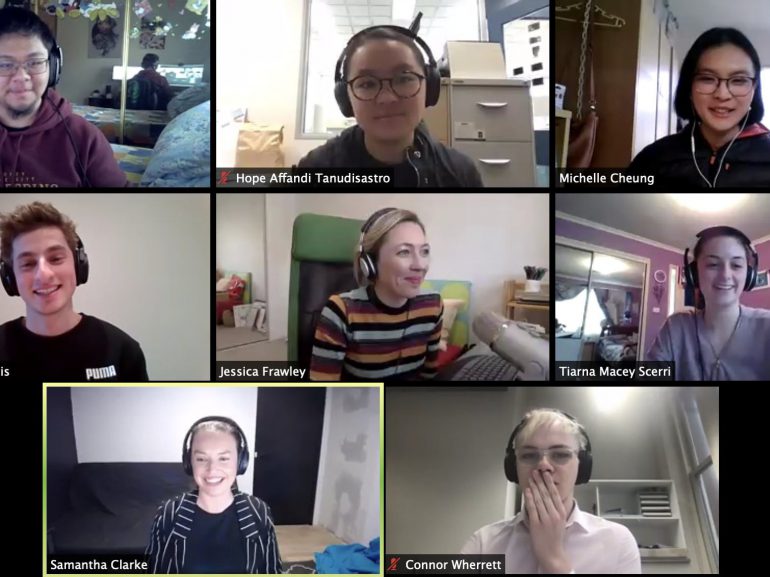Coming up for air after a semester like no other, on 8 July 2020 University of Sydney staff had a chance to “gather” online for the Education Portfolio’s Teaching Well and Supporting Students During COVID-19 symposium. Highlighting the efforts of “ordinary people teaching well in extraordinary times”, a clear standout of the symposium was a student-led panel which gave teachers vivid insight into the student experience of online learning – what teachers are doing well and where they could improve. The student panel busted myths about online learning, gave practical advice for teachers, and discussed their dream Zoom session.
This article was contributed by members of the student panel (Tiarna Scerri, Michelle Cheung, Frank Fei, Hope Tanudisastro, Nikita Papastamatis, Connor Wherrett, Sophia Nunez), Mick Warren, Dashiell Moore, Samantha Clarke, and Jessica Frawely.
Insight 1 – Busting myths around Zoom black boxes and the ease of learning online
What are students doing on Zoom when all you see is a sea of black tiles? While blank faces are always a challenge, a patchwork of miniature (mostly) blank screens is another thing entirely. But it turns out that students are turning off their cameras for much the same reason as everyone else. Some panellists on the symposium conceded that they could be distracted by emails and social media during Zoom classes. “Being a black square” can also be “comforting to a lot of people because no one can see what you’re doing”. Turning off your camera can afford a moment to visit the bathroom or kitchen with added privacy. But we shouldn’t be surprised that students are also making the most of an opportunity to take notes, grab a snack and generally “productively multitask”. For one student panellist, Zoom lectures presented an opportunity to “fold the washing or, do a [few] things around the house” while also listening and taking notes. Internet connectivity or other technological and accessibility issues might also preclude some students from using their camera (e.g. having to go to a public library to access the internet). This is not to say that students are not aware of the importance of having their camera on, particularly in breakout rooms. Several students mentioned that being visible to teachers and other students promoted engagement, connection and pressed them to be active in their learning. We should encourage our students to switch on their cameras, especially in breakout rooms because it helps us as teachers connect with them and also them with each other. We shouldn’t demand that students turn their cameras on given the myriad important potential reasons for not doing so.
Far from being “more efficient” and “able to handle” more work, students on the panel discussed feeling less productive
Clarifying this myth helps resolve another: that online learning is easier for students than studying face-to-face. Flexibility driven by the “freedom to direct your own learning” cuts both ways. The comfort of studying from home and not spending time travelling to campus is counterbalanced by the lack of structure, increased potential for distraction and overall disruption to learning routines created by COVID-19. Far from being “more efficient” and “able to handle” more work, students on the panel discussed feeling less productive, the burden of increased household responsibilities and missing the incidental encounters of campus life. That being said, one panelist made it clear that they had taken advantage of moments where they would otherwise be occupied while learning face-to-face – using what was travel time, for instance, as study time.
Insight 2 – Actively involve your students in and out of class
We also saw how student motivation to learn could be strongly influenced by the level of structure and guidance teachers provide. It was clear from the panel that students are taking control of their learning by maintaining self-motivation, setting schedules and deadlines, in addition to setting routines to look after their mental and physical health. But, there was also a very strong sense that panelists appreciated the extra scaffolding that was put in place to assist their learning, as well as signs of their teachers “being adaptable” in the COVID-19 context. Using different online platforms like Padlet is a good example of such adaptations, allowing students en masse to collaborate and “contribute their ideas” anonymously. Panelists also gave positive comments on teachers’ efforts to establish a “continual feedback loop” through online formative quiz platforms such as Socrative.
There are a variety of ways to give students a chance to gain feedback “about the things that people clearly didn’t understand.” Panelists encouraged teachers to be more active during Zoom classes, monitoring questions raised on chat and responding directly. Other approaches suggested included providing a “variety of resources that fit different people”, “compartmentalising” assignments to make them more manageable and considering open-book exams as they incentivise the upkeep of notes and active listening. However teachers reinforce the scaffolding of their units of study for online delivery, an essential request from the panellists was that their teachers communicate clearly and consistently, and through multiple channels (i.e. emails, Canvas announcements and directly during Zoom classes).
Some other ideas for teachers to consider to improve the delivery of their units include providing clear weekly structures on Canvas, time estimates for the completion of content, sending frequent reminders regarding due dates, making times available for catchup drop-in and generally being more easily reachable for students.
Insight 3 – Belonging, connection and personal engagement
It is not a revelation that students are more likely to be engaged in their learning when they feel that their teachers are listening and responsive. The distance and isolation created by COVID-19 makes this even more important. As we enter semester 2, we need to keep front-of-mind the strategies that build personal connections and help students feel secure and a sense of belonging at university. There were some pragmatic suggestions from the panellists of how teachers can personally connect with students and cultivate a positive learning environment. Visiting breakout rooms during group activities with a simple “Hey, how [are] you guys going?”, being available to chat before and after Zoom lectures are simple but effective ways of reminding students that you are at hand to help with any questions. In doing so, be mindful that some groups will be more active in their discussions so adjust your approach accordingly.
Visiting breakout rooms during group activities with a simple “Hey, how [are] you guys going?” is a simple but effective way of reminding students that you are at hand to help with any questions.
So how can opportunities for personal connection and engagement be enhanced? Even though pre-recording lecture material (asynchronous delivery) had advantages for flexibility and managing “retinal exhaustion”, the advantage of “real time lectures and tutorials” (synchronous delivery) was highlighted as a good way of replicating the connection and interaction of face-to-face learning. Some panelists indicated that large Zoom classes had the benefit of fostering more “insight from fellow classmates” on account of the likelihood of more questions being asked by classmates. By the same token, smaller classes were seen as increasing the chance of being asked an individual question by the lecturer or tutor. This can be a welcome prompt to “stay on top of [listening] a lot more”, but it is worth remembering that pedagogical best practice suggests not calling out students by name. Clearly-structured group work was also offered as an important way of cultivating student connection. One panellist commented that after the unfamiliarity of working online was overcome, groups could discuss what their “COVID experience has been like.”
When asked about their “greatest Zoom class of all time”, one panelist gleefully retold the story of a tutor encouraging “everyone to bring out their dogs, or their cats, to the Zoom screen, and wave hello.”
In general, there was a strong suggestion from the panel of the need to provide a space where students could empathise with one another “in terms of what lockdown is like, and what online learning is like, and what sucks and what’s great”. As one panelist remarked: “The only connections that I was able to have in Zoom classes was with the people that I already knew…my teaching experience was very, ‘I am the tutor, here is everyone’. Which just doesn’t create any opportunities for those kinds of, accidental social interactions that lead to genuine relationships.” An alternative approach mentioned was the scheduling of a “social hour” by a lecturer every Friday which was “helpful in just creating a safe space for people to de-stress, relax, and just meet new people in the same class.” Such events go some way in replacing the spontaneity of grabbing a coffee or gathering on the grass in between classes. Within reason, teachers should in general not be afraid to “be more casual” and “candid” with their students, to accept and even encourage moments when the “dog would walk into the background.” When asked about their greatest Zoom class of all time, one panellist gleefully retold the story of a tutor encouraging “everyone to bring out their dogs, or their cats, to the Zoom screen, and wave hello.” A moment was also shared of how a “tutor’s husband actually handed her some flowers in front of the screen.”
These human (and animal) moments appear to be less of a “disruption” as they are a crucial means of helping students feel connected and a sense of belonging as the experiment in online learning continues.
“We appreciate your hard work!” A final message from the students
Showcasing the diverse teaching solutions Sydney staff developed in response to COVID-19, the Teaching Well and Supporting Students During COVID-19 symposium was a huge success. It is rare for students in particular to be given a forum to provide feedback in “real-time”. The above insights were offered in the same spirit of collaboration as the rich and diverse contributions made by teachers in the other sessions. To say that learning online is not “easy” is also to say that it is “different” and, as such, presents a range of new challenges to teachers and students alike. Teachers’ efforts to make learning possible in these challenging times has not gone unnoticed!
In the words of one panelist:
As students, we can only imagine how much effort it takes just to transfer an entire unit”s content online whilst still keeping us in the loop about changes, addressing individual concerns and embracing technology issues. But what we do know is how much additional effort is required to recalibrate how you present yourself to fit an online setting and how daunting that can feel. It is from that shared experience that we think any effort educators make to help us learn and feel more connected to both our learning and each other is appreciated beyond words.
Want to know more?
If you would like to read more about the symposium, check out the links below:
- To watch the panel in full, access a copy of the panel transcript, University of Sydney staff can visit the Teaching Well and Supporting Students During COVID-19 symposium recordings page. You can also engage with the recordings and resources compiled from the rest of the symposium day.
- Visit the COVID teaching support Canvas site for an overview of resources to support teaching off-campus.
- The recent Staff News article on student panel insights also highlights some of the insights from the student panel.






5 Comments